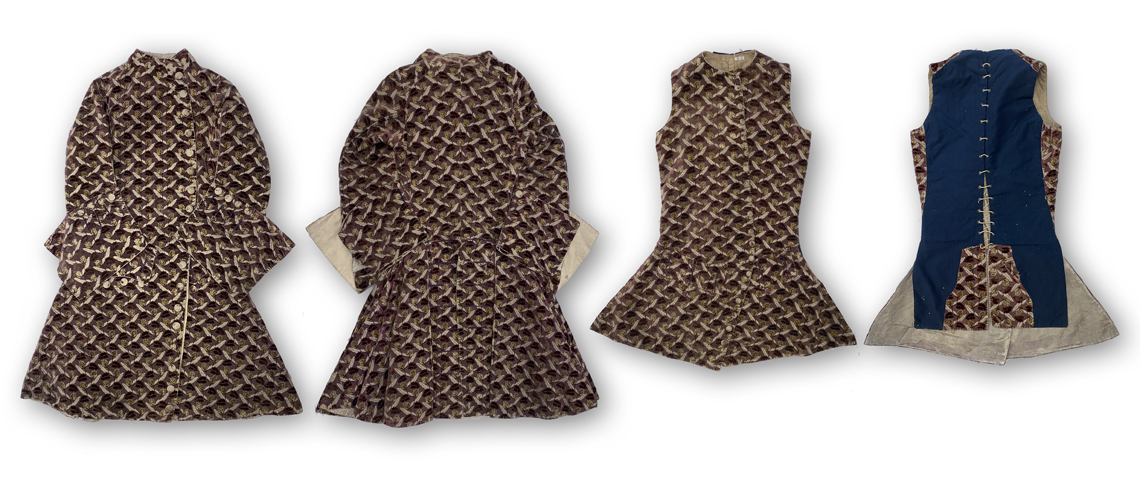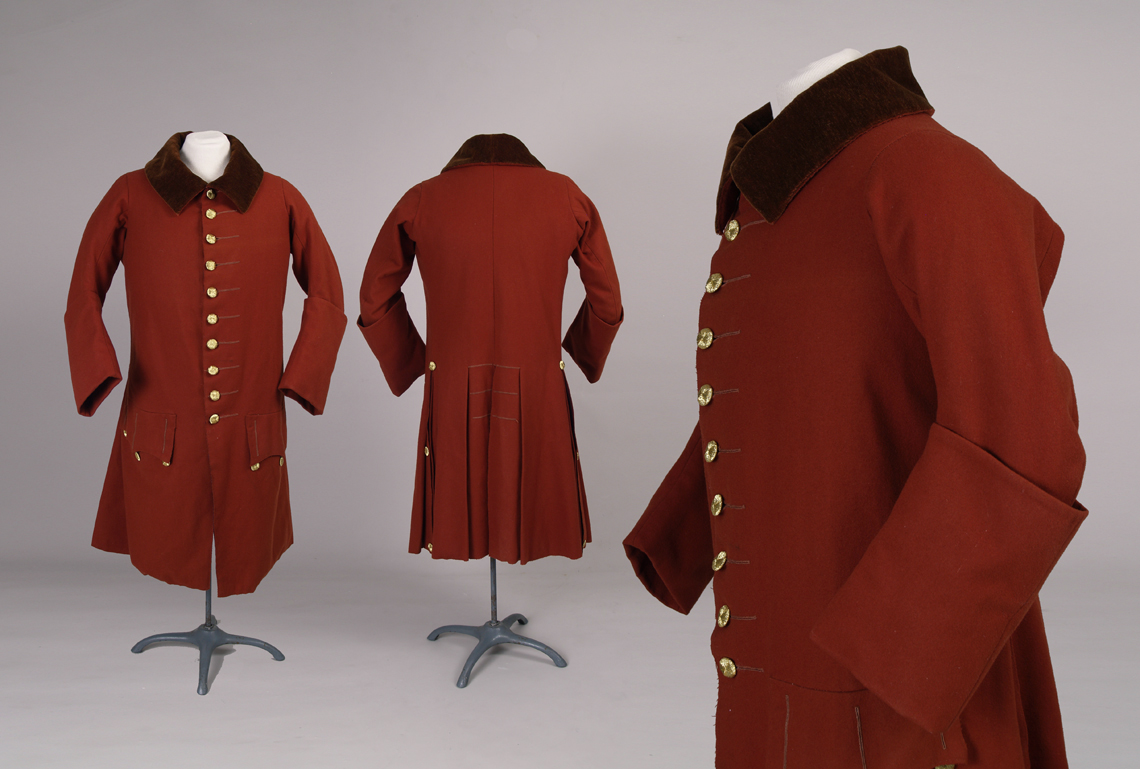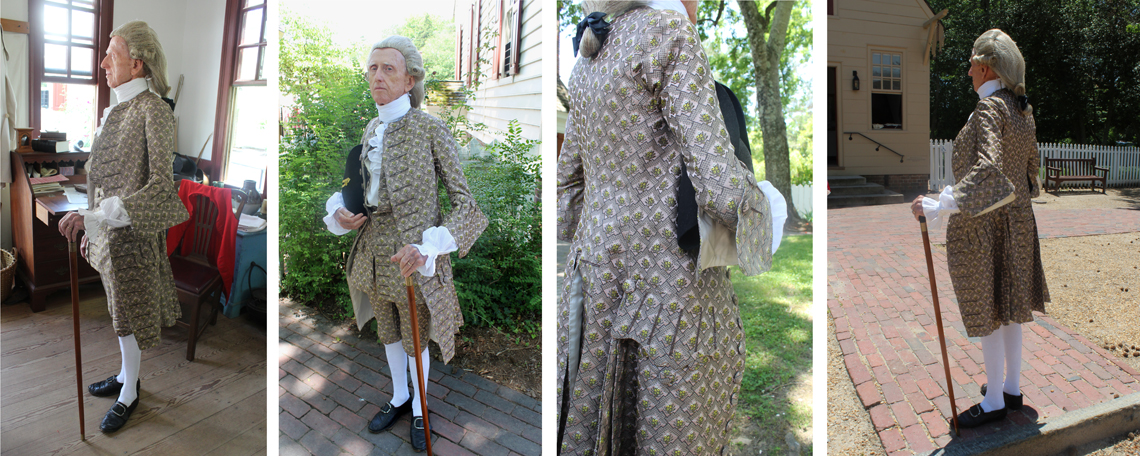
DRESS & ESCAPISM - THE DRESS RESEARCH EXHIBITION SERIES
Part 1 of 3: Dress Artifacts & Curatorial Practices
A Virtual (and Evolving) Exhibition
Anne Bissonnette, Lead Curator
Josée Chartrand and Katelin Karbonik, Contributing Curators
June 30, 2020 – June 30, 2021
Part 1 Home | The Blair Suit Reproduction | The Robe à la Française Reproduction | The Mid-1790s Chintz Gown | The Chemise Dress | The 1796 Reproduction Wedding Gown | The Maid's Dress
Reproduction silk suit (including breeches, waistcoat and coat)
Made by the Colonial Williamsburg Tailor Shop
On loan courtesy of The Colonial Williamsburg Foundation (T072-2019, 2)
Mount, photographs, and montage by Anne Bissonnette©
Colonial Williamsburg is a living history museum that re-enacts life in eighteenth-century Virginia. Many of its staff members are experts on trades of this period, including wig making, millinery, mantua making (i.e. dressmaking), and tailoring. They learn their craft as people did then: first as apprentices and, after many years of practice, they may become masters of their trade. They do this with the same kind of tools and in similar attire and settings. Their knowledge of 18th-century material culture may also be augmented by research in the collections of the DeWitt Wallace Decorative Art Museums, where a coat that was worn by judge John Blair (1732-1800) of Williamsburg can be found.
The Blair suit is quite exceptional. The fabric is striking: made of voided uncut silk velvet, it features fruit and foliage sprigs in green and purple in lozenges that repeat over a pink ground. Through these colours are common for 18th-century men, the elaborate nature of the fabric would have served to identify the wearer as a man of means. Worn in Virginia, the fabric of the suit is said to have originated in England.[1] This was not unusual for individuals in the American Colonies and, like fellow Virginian George Washington, judge Blair must have recognized the “great social and economic significance” of textiles.[2] At a glance, Blair’s contemporaries would have recognized the intricacies of this luxurious and likely very costly velvet. The aesthetic and monetary value of the fabric is likely why the coat was remade around 1770 from an earlier style.
The Colonial Williamsburg Tailor Shop, headed by Master Tailor Mark Hutter, re-created this earlier style that is rooted in fashionable menswear of the mid-18th century. Extensive research was conducted and a reproduction fabric was woven specially for the project, a costly endeavour made possible by financial backing from a generous donor. The care and energy taken to reverse engineer this earlier suit represents the very best in the field. The reproduction even echoes the size of the wearer, which is quite small. The goal was to bring the object back to its original glory without altering the coat as it stands today. The results are not unlike a suit in the Anne Lambert Clothing and Textiles Collection (Figure 1) in both structure and aesthetics.

Figure 1
Maroon and gold silk coat and waistcoat (breeches not pictured)
Unknown creator, Ireland, mid-18th century
Cut and uncut silk velvet, linen and silk lining
Anne Lambert Clothing and Textiles Collection, Department of Human Ecology, University of Alberta
Donated by Ms. D. Colvin-MacDormand (1995.1.1ab)
Photographs and montage by Anne Bissonnette©
The small size of the suit may have played in its survival. Smaller garments have higher survival rates as they cannot be altered as easily. This contributes to the false impression that “people were smaller then,” a myth addressed by dress historian Linda Baumgarten.[3] Diminutive bodies cause problems for museum professionals as few mannequins are available in very small sizes, and none have the proper posture of the 18th century with shoulder pushed back and down. Because of this, a form had to be hand-carved in museum-grade foam for the Blair reproduction suit to be safely presented three-dimensionally. Ensembles and individual pieces (Figure 2) presented on mannequins and dress forms are interesting in and of themselves, but they are better understood in context and on living bodies, something reproduction pieces can allow (Figure 3).

Figure 2
Reproduction rust-colored wool frock coat
Made by the Colonial Williamsburg Tailor Shop
On loan courtesy of The Colonial Williamsburg Foundation (T072-2019, 1)
Mount, photographs, and montage by Anne Bissonnette©

Figure 3
Ike Cech and Daniel Rosen wearing reproduction clothing made by the Colonial Williamsburg Tailor Shop, including red and white striped jacket, linen trousers, and rust-colored wool suit with yellow striped silk waistcoat.
The Colonial Williamsburg Foundation
Photograph by Mark Hutter
In this Cinderella story, Hutter had to wait to find a person that would fit the suit. The result was worth the wait: seeing the reproduction suit on a living body demonstrates dress practices of the mid-18th century in an engaging and comprehensive way that goes far beyond what can be done with a static mannequin (Figures 4, 5, 6, 7). Such reproductions can help us to understand the past of an altered artifact and convey a fuller story where posture and motion are part of the life of a garment.

Figures 4-7
Colonial Williamsburg guest, Patrick Mahoney, wearing a reproduction of the suit worn by John Blair, Sr. (4: interior, side-front view; 5: exterior, side-front view; 6: exterior, side-back view; 7: exterior, side-back view, outside the Durfey Tailor Shop).
The Colonial Williamsburg Foundation
Photographs by Mark Hutter
Have you had an “aha moment” when wearing reproduced period attire?
Share your thoughts by e-mailing anne.bissonnette@ualberta.ca and we may add your story to bring different perspectives on this subject.
|
October 5, 2020 "You asked at the end if anyone had an "aha" moment in wearing a period garment. I have one that I've told many times. I am, you may recall, a member of The Brigade of the American Revolution, an umbrella group of reenactors representing many units who fought on both sides of the Revolution. Some years ago I gave a workshop for the Brigade on 18th century deportment. It included standing, walking, etiquette, forms of polite address, etc. I began, of course, with posture. I explained that the typical slightly slumped posture that many of us have today was not representative of good posture in the 18th century. I demonstrated a straight back with shoulders back, and asked the participants to try it. One of them immediately said, "My coat fits! I just had a new coat made by a tailor who makes 18th century suits, but I thought he had done a bad job. But my coat fits!" So, kudus to a tailor who knew what he was doing, and here's hoping for better posture among more reenactors. Best Regards, Phil Dunning" |
[1] “Coat,” Object number 1981-180, Colonial Williamsburg, The Collections, https://emuseum.history.org/objects/47247/coat?ctx=e00964f87247f06a07c4824fd52ec7f9e91592ab&idx=8.
[2] Wendy Lucas and Noel Campbell, "The Economic Significance of Cloth and Apparel: An Analysis of George Washington's Shipping Receipts, 1754-1772," Essays in Economic & Business History 34 (2016): 1.
[3] Linda Baumgarten, What Clothes Reveal: The Language of Clothing in Colonial and Federal America, Yale University Press, 2002, 66.
Support for the exhibition was provided by a KIAS Dialogue Grant from the Kule Institute for Advanced Study and a CIP Artist Project Grant by the Edmonton Arts Council and the City of Edmonton.



This exhibition also draws on research supported by the Social Sciences and Humanities Research Council. The following individuals have contributed to Dr. Bissonnette’s research thus far: Josée Chartrand, Meg Furler, Peggy Isley, Katelin Karbonik, Patricia Siferd, and Sarah Woodyard.

